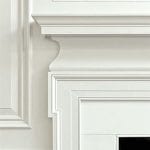Hey Guys,
This has been a very architectural time recently. I know that many of you want me to continue with the mcmansions. And, I will most likely get back to them. However, for those who prefer other types of posts, I don’t want to make you feel unheard.
Plus, it’s always a good idea to hone the bones of our rooms, if possible.
And, I’m so glad that most of you enjoyed the last post about the hideous mcmansions. In addition we also looked at classical interior architecture a week ago.
But, I want to get back to the classical architecture, because I would like to discuss in greater detail how we arrive at the perfect architectural proportions for our homes. Is there some magic formula?
Good question, huh? Well, actually, yes, there is!
And, I think it’s an important topic because I am frequently asked “How high should the wainscoting be?” “What size should the crown moulding be?” “What about the fireplace mantel?”
Well, today, I’m going to show you a relatively easy way to figure it all out. Or, at least how to get the proportions correct.
By the way, proportion is the scale compared to some other thing. But scale is not dependent on something else. Some folks use them interchangeably, but they are two different concepts.
For instance. That chair is a small scale.
Or, the mirror is too small for the chest it’s going over and the wall it’s on. It’s too dinky. The proportion is all wrong.
But getting back to the formula for perfect architectural proportions.
It has to do with the mathematical element that is connected to every organic thing in the Universe, including our galaxy and others.
We touched on it in this post when we discussed Metrie Mouldings. (please take a minute and check it out.
But, today, we are going to examine this formula in greater detail.
And, this is the mathematical concept of what is commonly known as the golden ratio.
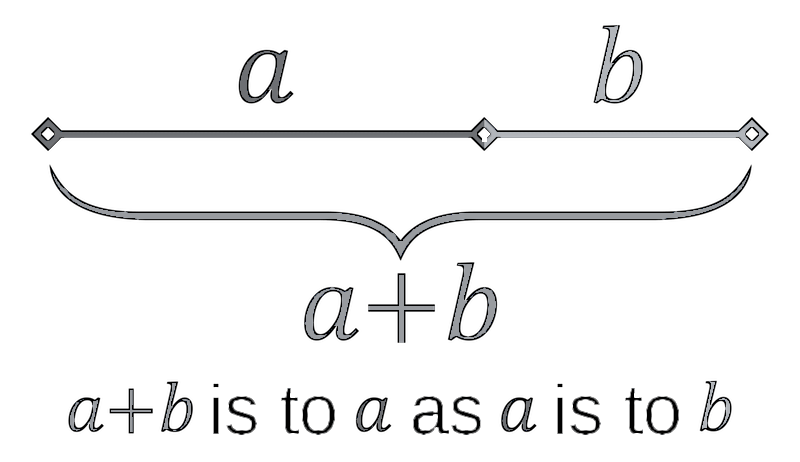
This formula is expressed with the Greek letter phi.

Phi stands for the mathematical formula for the golden ratio, sometimes also called the golden mean or the Divine ratio.
The golden ratio is based on a mathematical formula where two numbers are added together to make the next number in the sequence.
AKA: The Fibonacci Sequence
1, 1, 2, 3, 5, 8, 13, 21, 34, 55, 89…
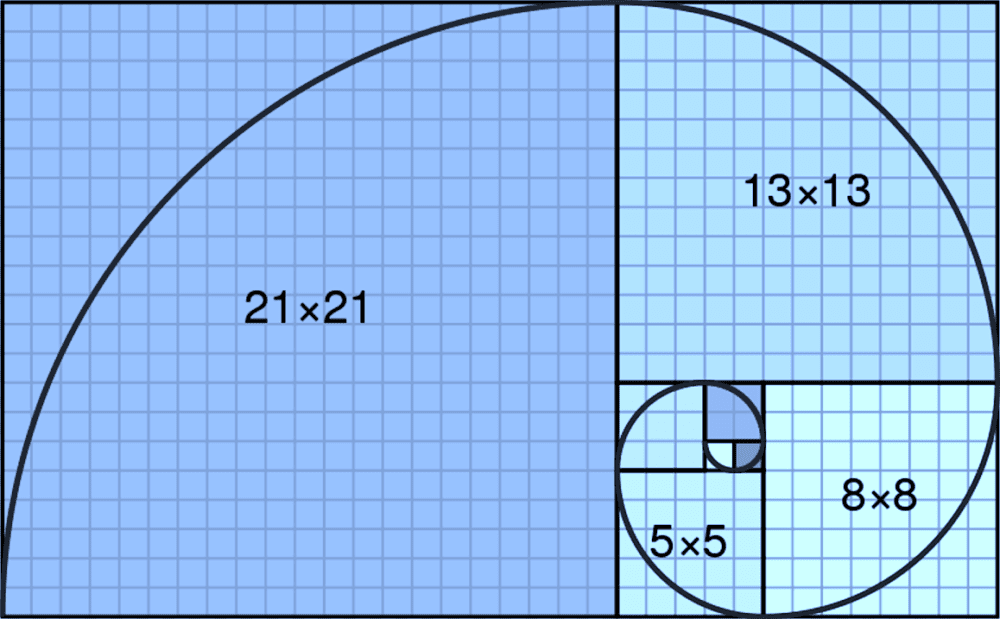
Or, it can be expressed as a spiral. Every square and rectangle = the same ratio which 1:1.618.
It is easy for me to remember because my son’s birthday is 6.18. :]
Did you know that the ratio from the floor to your navel (1) and then from your navel to the head (.618) is roughly 1: 1.618
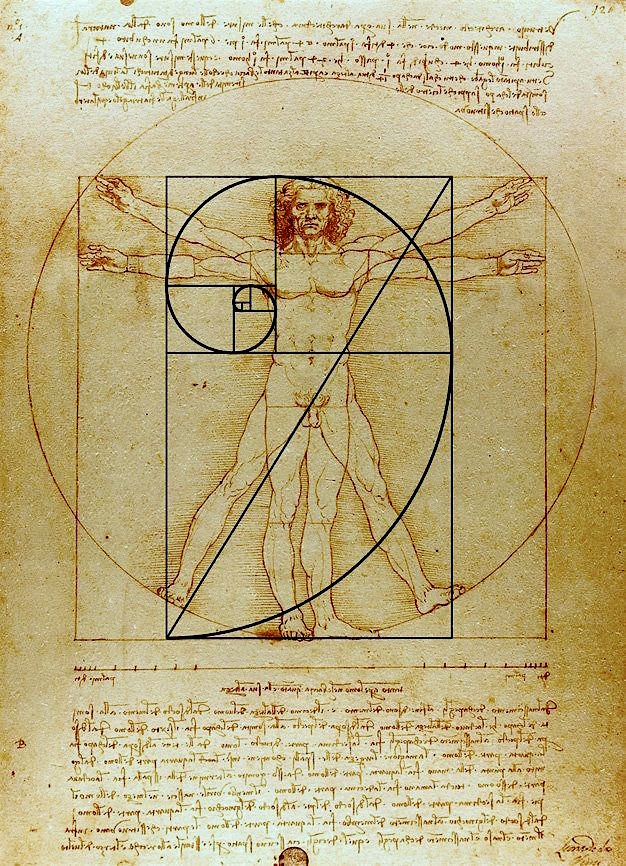
There you go. Leonardo Da Vinci’s iconic Vitruvian Man. The number 1 is represent by each side of the square below the man’s naval. The rest of his height from his naval on up is .618. Henceforth, the ratio 1:1.618.
But, it doesn’t end there. The hand to the elbow and then the forearm to the shoulder. The ankle to the knee cap and then the knee to the hip.
Yes, of course, there are some small variations. But, in the scheme of things, they are not terribly significant.
And, that’s a very good lesson regarding proportion in architecture.
Seriously, don’t get your knickers in a twist about it. It’s a guide-line, not Laurel is going to jackhammer you if you’re a half an inch off or even several inches off if the scale is fairly large.
The examples we saw on Wednesday are not a half inch off. They are not a half of a foot off.
They are a football field off!
Okay, fine. I’m exaggerating. But, not by much!
For today, I want to show you some cool things I’ve discovered and how we can use the golden ratio to create perfect architectural proportions for our homes.
Today, because I think I’d like to try and get an hour or two of sleep, I’m only focusing on the exteriors. But, know that whatever is going on outside, can be applied inside, as well.
For Wednesday, I will most likely take these principles inside to examine the placement of mouldings, windows, wainscoting, etc. I thought I was going to do that today. But, that’s typically me, biting off way more than I can consume in one day.
However, I’m having a lot of fun with this exercise and I hope that you’ll enjoy it too.
Architects from at least the Renaissance onward have used the golden ratio in their designs. And that is why they are so pleasing.
In fact, I read a study where a group of people were shown ten rectangles of different proportions. They were asked to choose which rectangle they found most pleasing. The rectangle that was most frequently chose was the one which measured 5 on the short side and 8 on the long side.
OH, something else I found. And you’re going to love this. This is a link to a golden ratio finder. So, if you know what (1) is, it will tell you what .618 is. Or, vice a versa.
I found numerous examples dating back to the renaissance where we can see the perfect architectural proportions conveyed by the golden ratio.
But, unfortunately, it is not always possible to find out who did the work. If I did an overlay on an image, I put my watermark on it.
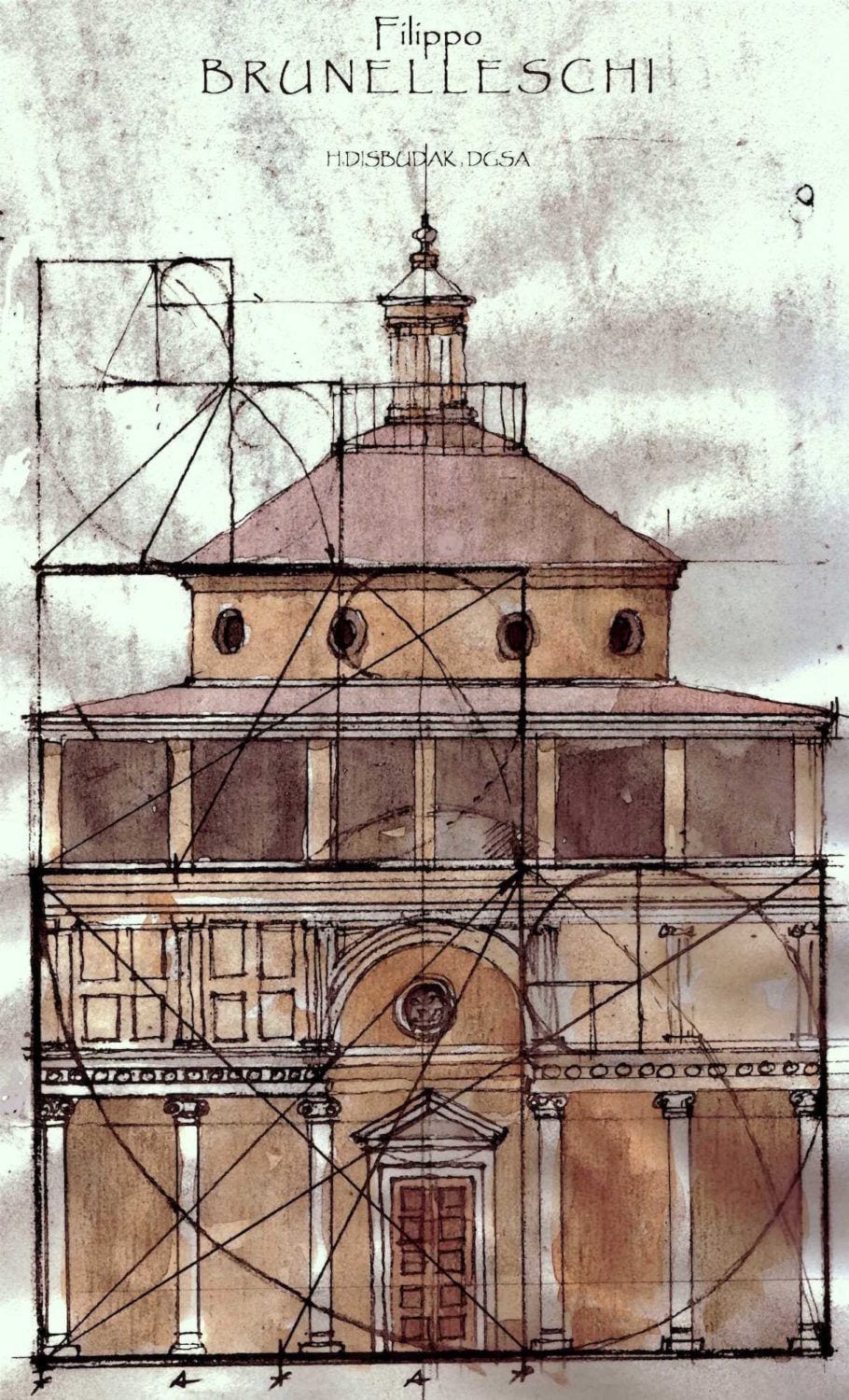 Brunelleschi and the Fibonacci Principle His use of proportions are based on the golden ratio. How cool is this beautiful watercolor!!! I wish I knew who did it. Yes, there’s a name like it’s a book cover, but I could not find this person or this book.
Brunelleschi and the Fibonacci Principle His use of proportions are based on the golden ratio. How cool is this beautiful watercolor!!! I wish I knew who did it. Yes, there’s a name like it’s a book cover, but I could not find this person or this book.
But, there’s more.
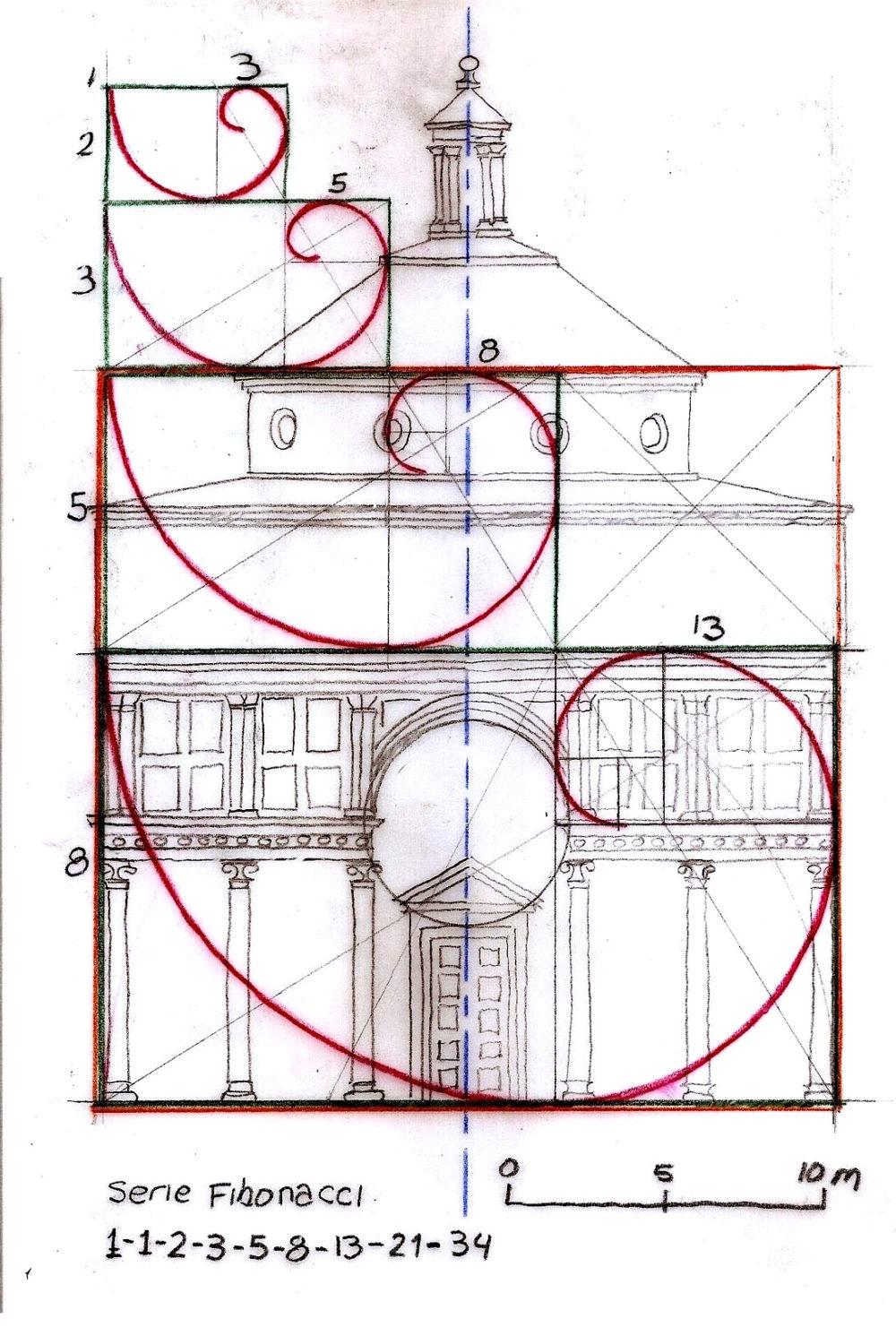
This is a line drawing as you can see of the same building. There’s something so pleasing about these images. Well, of course, they all convey the golden ratio!
Let’s move on to more recent times.
Below is a line drawing of a classical Georgian-style home.
This one is quite easy to understand because it is perfectly symmetrical.
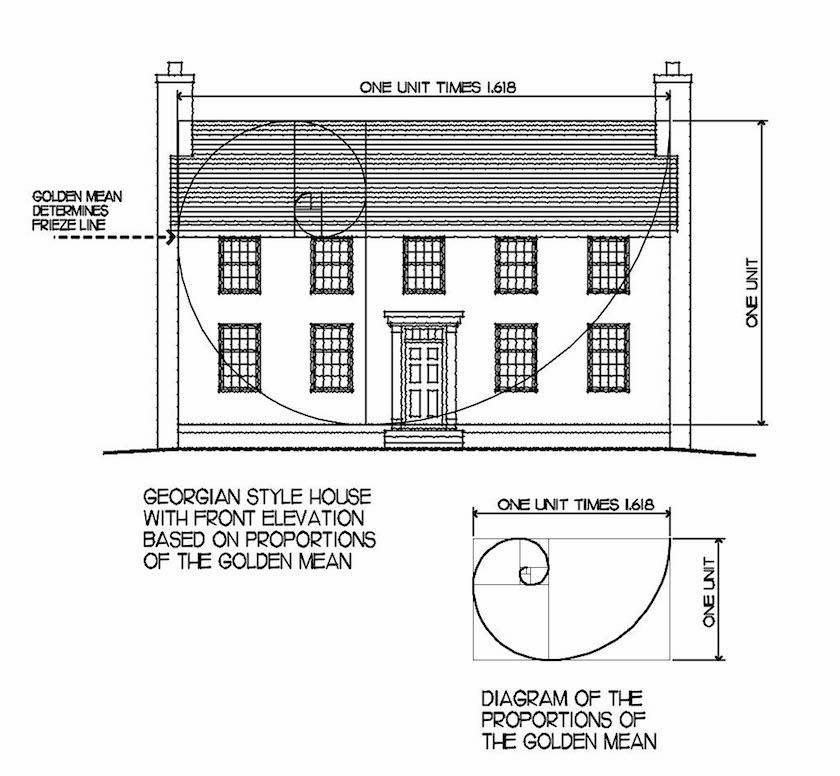 Sorry, I don’t know where the above image is from. It shows how the golden ratio can be used to find the perfect architectural proportions.
Sorry, I don’t know where the above image is from. It shows how the golden ratio can be used to find the perfect architectural proportions.
By, the way, I downloaded Ben Pentreath’s book (Get Your House Right) on kindle (it’s also available in hard copy) and it is superb. Well, of course it is. Ben wrote it!
There are many wonderful examples of what to do and what NOT to do.
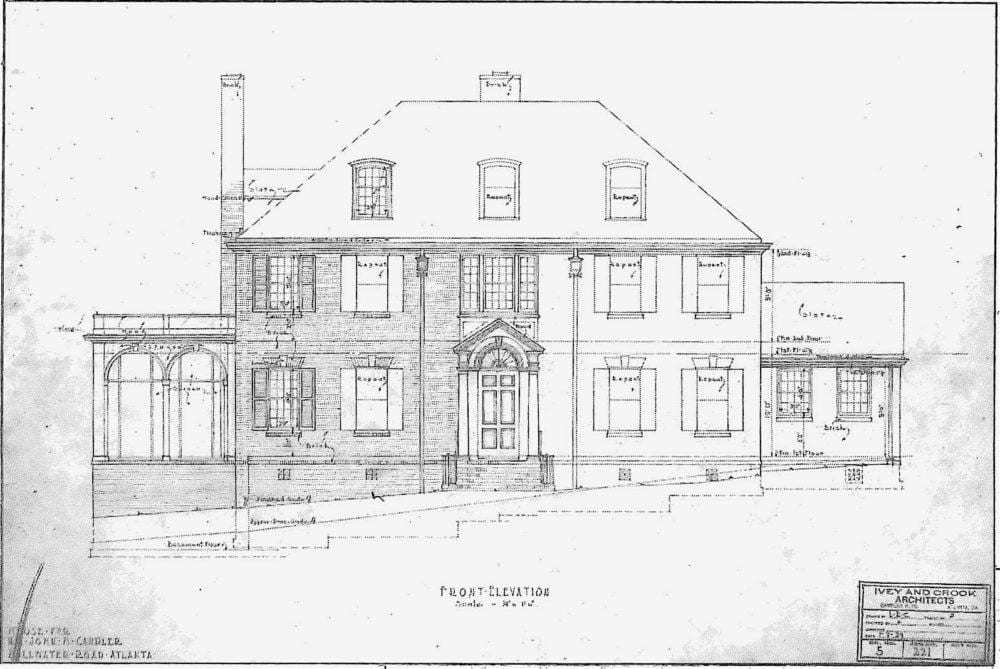
front-elevation via the georgian revival files
Here’s where I had a lot of fun today. I found the above elegantly classical Georgian home that was drawn in 1929.
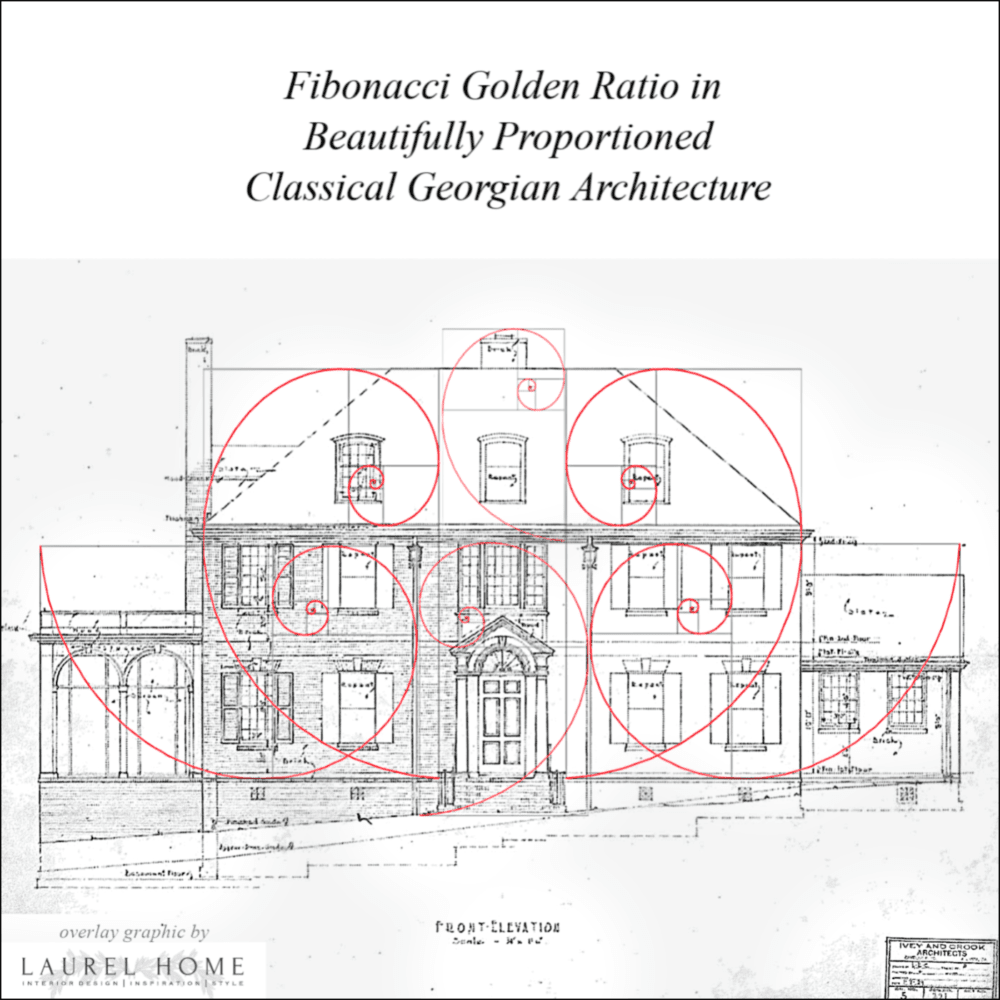
Make no mistake, I could’ve probably kept going, but you get the idea.
There is a wonderful blog by architect, Richard Taylor.
I don’t often see architects with blogs, but this one is excellent. And, I recommend that you check out this post, where he explains his design process for finding the correct architectural proportions.
Not only does he use the golden ratio, he makes use of the golden triangle which is another aspect of the formula that architects and designers can use to derive the perfect architectural proportions.
However, I had more fun with the golden ratio.
I think it’s great to be told that something is classical. But, this examination into WHY it’s classically correct, I think is very beneficial because then we know better what to look for.
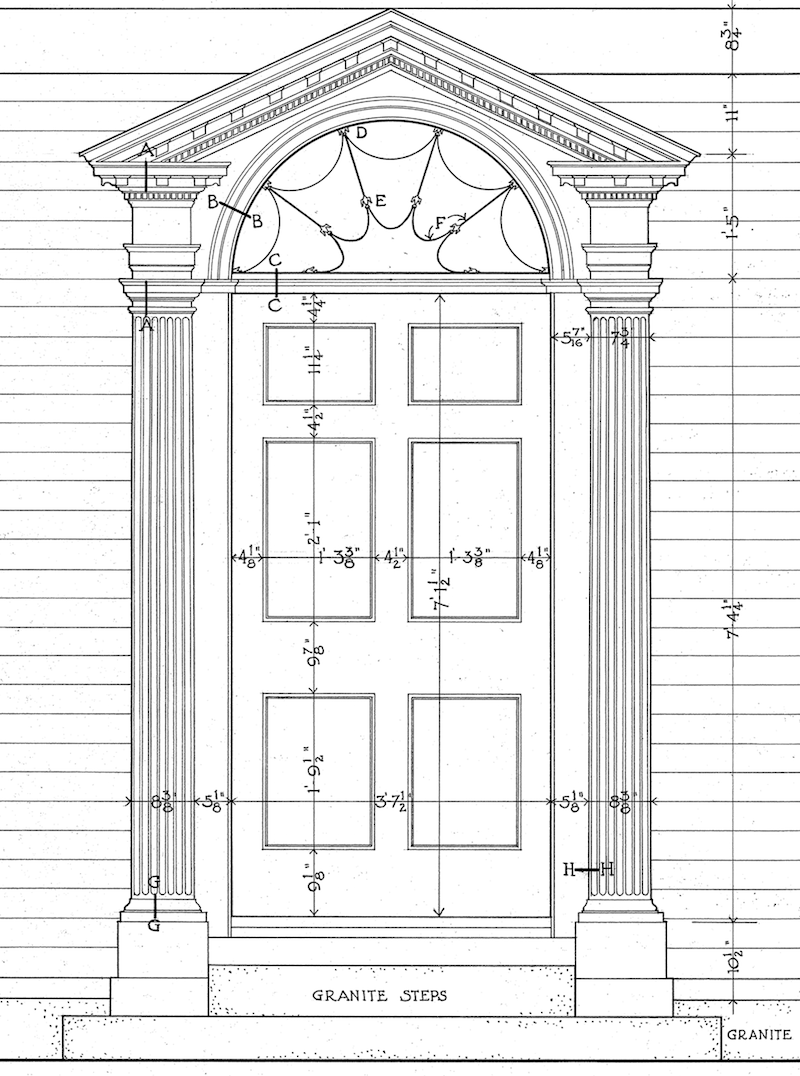 Above is a Georgian door with perfect architectural proportions. I won’t get into all of the architectural terms, but it is flanked on either side by what look like pilasters (engaged columns) that are in the doric order.
Above is a Georgian door with perfect architectural proportions. I won’t get into all of the architectural terms, but it is flanked on either side by what look like pilasters (engaged columns) that are in the doric order.
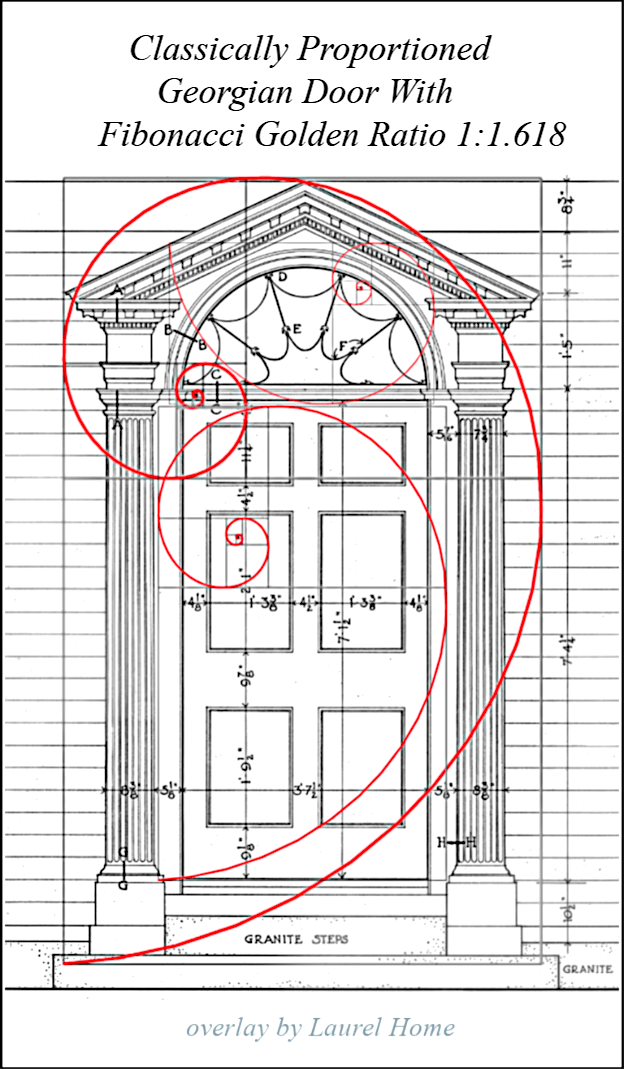
The squares and rectangles are there, but are not easy to see. But, maybe you can see that one of the horizontal lines of the smaller rectangle intersects the middle panel, almost dead-on in the middle.
And the large rectangle hits the parameter of the entire door surround.
I was a little nervous about this post because I was thinking about it for a few days, and this was the general idea, in my mind. But, I wasn’t sure if it would work out. However, if it didn’t, that would be a learning experience too!
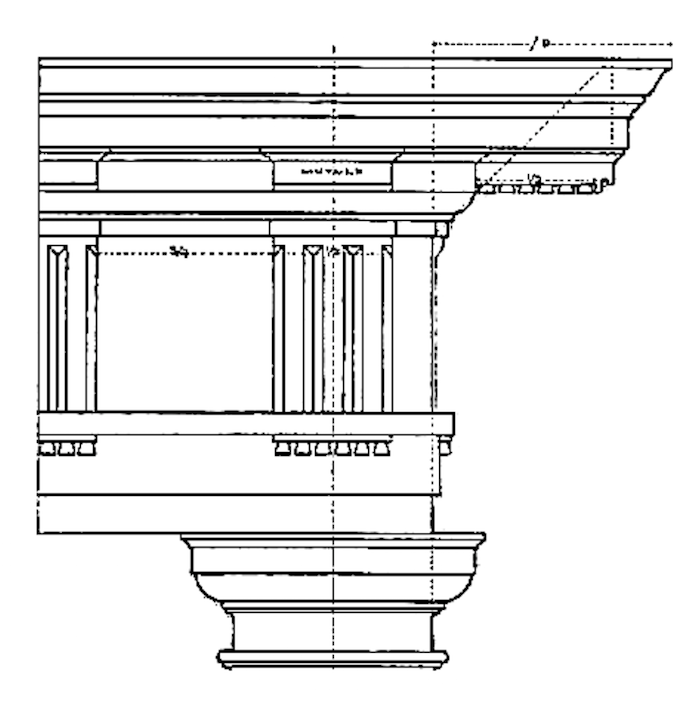 Actually, the first one I did was this doric entablature.
Actually, the first one I did was this doric entablature.
Before I show you what I did, I’m embedding a wonderful video by Todd Murdock.
This is the best explanation of classical proportions I have ever heard or read. And he does it with a power-point presentation. It is very clear and easy to understand.

He recommends William Ware’s book, The American Vignola. You may recall that we spoke of Vignola as one of the renaissance architects who laid out the five classical orders. But, he says that the original is impossibly difficult to follow.
Below is the entire Doric order with the entablature and column. There is also a base, but this image doesn’t show that.

Above is a classically proportioned Doric Column another wonderful blog post from This is Carpentry. I highly recommend that you read it. The Doric order is eight diameters tall. But, that is all explained in the video.
Getting back to our entablature. Below is what I did to show why these are perfect architectural proportions. Or, at least I tried to.
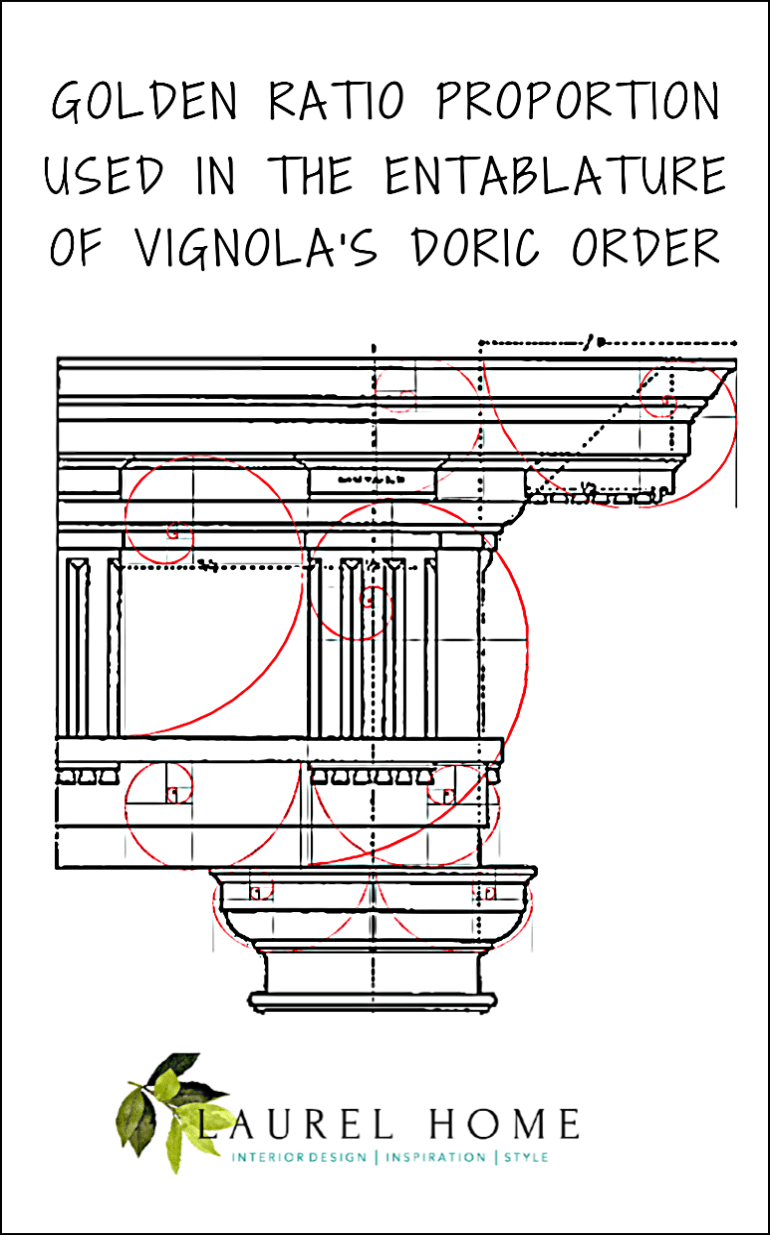
There are golden ratio rectangles every which way! So cool.
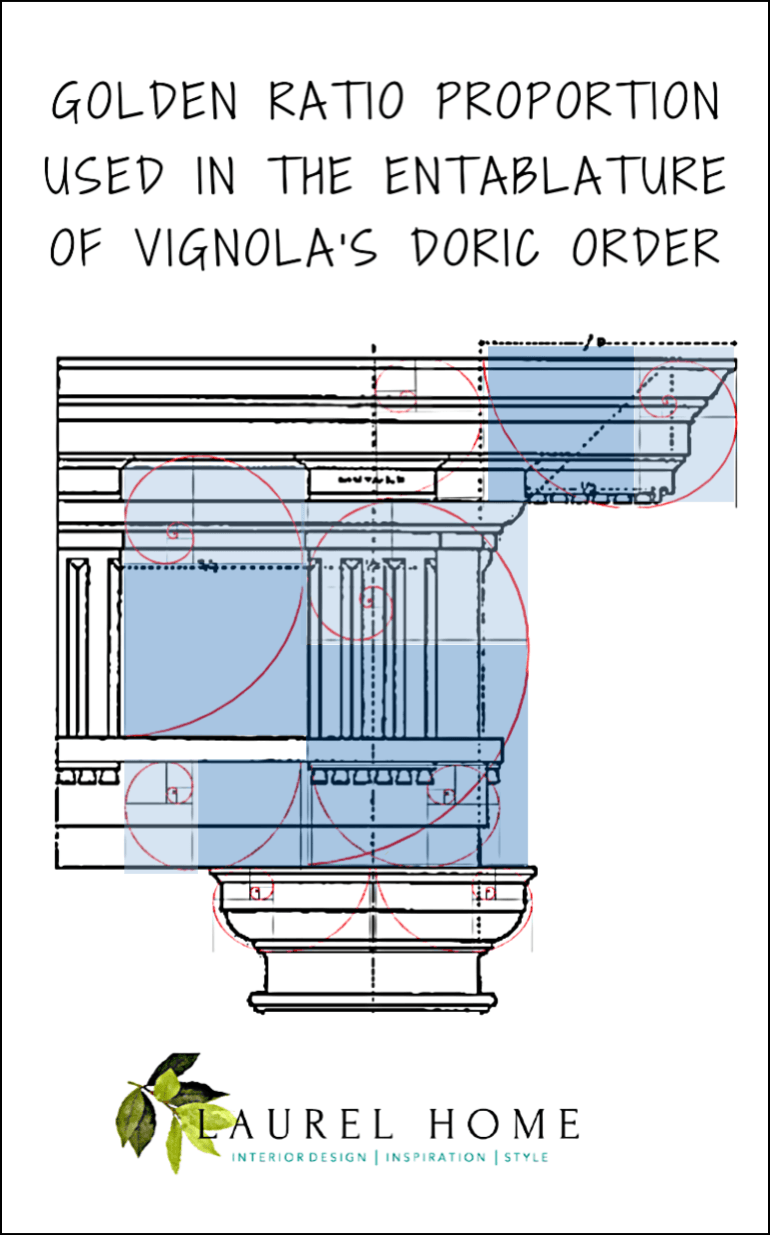
This is another version so that you can easier see the squares and rectangles that create the 1:1.618 ratio. Please feel free to pin any of these graphics to pinterest for handy reference.
Frankly, over the years, aside from drawing things out, I frequently eye-ball where things should go. How many of you do that too?
However, if you’re building a house or furnishing a room, eye-balling isn’t enough!
But, an interesting point that Todd Murdock says in the video is this: There are several experts who’ve written about the perfect classical proportions. And, he shows a diagram of the columns side-by-side. Yes, they are all different from each other. However, the differences between most of them are very slight.
In fact, if they weren’t right next to each other, you probably wouldn’t notice the difference in two homes a mile apart from each other.
So, again. These are merely guidelines. And, as such it is fine to deviate from the ideal. One reason for this is that the exterior of the home needs to look good, but the interior also needs to look good and function beautifully.
Sometimes, it’s a tough call. And generally, the inside of the home is going to win out. That makes sense since our homes are there to shelter us.
This has been a learning experience for me this week and I hope that it’s given you some new insight into how architects and interior designers create classically accurate proportions.
xo,

Please check out the updated hot sales. And, also, hot off the presses! Nordstrom has added hundreds of new items to their Anniversary sale.! They do that a lot in the last week. So, even though some things are sold out, they are continually adding new items.
You can also check out some of my favorite items here. The sale ends August 4th.
Related Posts
 Painted Wood Furniture – Cringe Worthy, Dated, or What?
Painted Wood Furniture – Cringe Worthy, Dated, or What? The Best Bedroom Paint Colors You’re Probably Not Using
The Best Bedroom Paint Colors You’re Probably Not Using The Perfect Shade Of White Wall Paint For Oak Trim
The Perfect Shade Of White Wall Paint For Oak Trim The Ultimate Guide To Fireplace Mantel Decorating
The Ultimate Guide To Fireplace Mantel Decorating Gorgeous Bathroom Vanities + Sinks, Faucets, Mirrors, Lights
Gorgeous Bathroom Vanities + Sinks, Faucets, Mirrors, Lights The Guaranteed Way To A Beautiful Room (It’s Not The Wall Color)
The Guaranteed Way To A Beautiful Room (It’s Not The Wall Color) Little Known Exquisite, Affordable Wallpaper Murals & Art
Little Known Exquisite, Affordable Wallpaper Murals & Art








